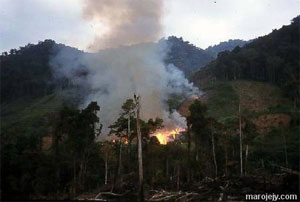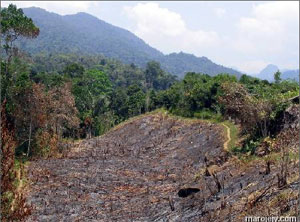Madagascar increases fines for forest burning
Madagascar increases fines for forest burning
mongabay.com
January 3, 2008
|
|
Madagascar will increase penalties for people caught setting land-clearing fires on the biodiverse island, according to a report from Deutsche Presse-Agentur.
Thursday Environment Minister Harison Randriarimanana announced new fines for farmers practicing “tavy”, as slash-and-burn agriculture is known in Madagascar, and unveiled plans to educate the country’s mayors about the environmental impact of bush fires, which burn across as much as one-third of the country each year. He also said that reforestation efforts by individual Malagasy, as the people of Madagascar are known, could reforest 100,000 hectares of land with 200 million trees.
The announcement comes two months after an international team launched a real-time satellite monitoring system of Madagascar’s fires. The Fire Alert System — a collaborative effort between Madagascar’s ministry of Environment, the International Resources Group, and Conservation International with USAID funding — allows anyone with an Internet connection to see where fires are burning. The system includes email alerts that notify subscribers when a fire has been detected in a specified area.
 Fire and forest clearing in the Marojejy area. Photo by Paul Atkinson  Slash-and-burn along trail just outside park boundary. Photo by Paul Atkinson, courtesy of www.marojejy.com |
Madagascar, a biologically rich, but economically poor island country located off the southeastern coast of Africa is almost as famous for its environmental problems as for its lemurs, a charismatic group of primates found nowhere else on Earth. The country is home to some 90 types of lemurs as well as a bonanza of other rare and unusual creatures including a puma-like mongoose, spiny hedgehog-like beasts called tenrecs, and absurdly colorful chameleons. But these creatures are highly threatened by habitat destruction, most of which results from slash-and-burn agriculture that has left less than 10 percent of the island’s original forest cover standing.